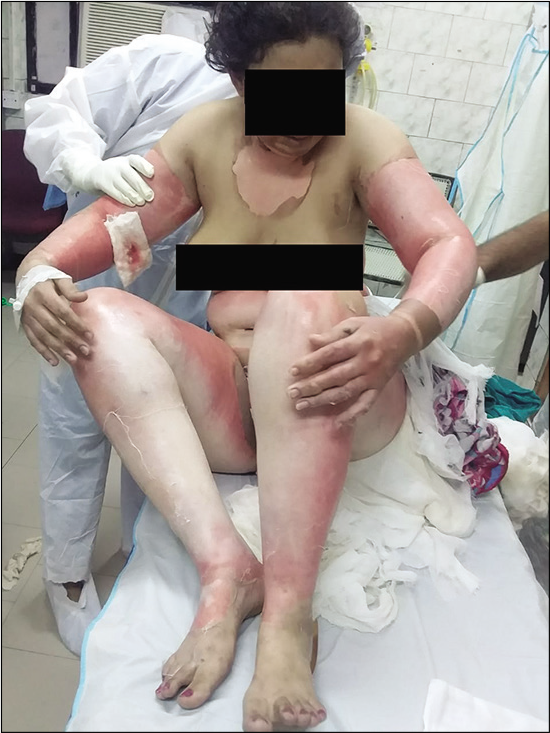Translate this page into:
Alcohol-based hand sanitizer-induced burns: A harsh reality in current times
*Corresponding author: Amrita More, Department of Burns, Plastic and Maxillofacial Surgery, Vardhman Mahavir Medical College and Safdarjung Hospital, New Delhi, India. dr.amrita47@gmail.com
-
Received: ,
Accepted: ,
How to cite this article: Gupta D, More A. Alcohol-based hand sanitizer-induced burns: A harsh reality in current times. Indian J Med Sci 2022;74:40-3.
Abstract
Due to the recent coronavirus pandemic, there is a steep rise in the use of alcohol-based hand sanitizers (ABHSs) over the past few months. For them to be effective against microorganisms, the minimum recommended concentration of alcohol is 60%. This high alcohol content makes the sanitizers easily flammable. Although, they are extremely convenient to use, they can also prove to be a hazard if used in an improper manner. Guidelines have been published for safe manufacturing and distribution of these sanitizers. There are recommendations for storage and use, which should be adhered to in a strict manner. Their use by children should always be supervised. We report four cases of burn injuries caused by injudicious use of alcohol-based sanitizers. The flammable nature of ABHSs can also be exploited as witnessed in one of our cases. With this report, we wish to emphasize that judicious and correct use of these seemingly benign products is essential.
Keywords
Burns
Sanitizer
Alcohol
Hand hygiene
INTRODUCTION
In the wake of COVID-19 pandemic, maintenance of hand hygiene is garnering a great deal of attention. Maintaining a 3 feet distance, regular washing of hands with soap and water for 20 s and not touching ones face along with practice of respiratory etiquettes, are by far the best way to prevent transmission of COVID-19 infection.[1] In situations where water and soap are not available, Centre for Disease Control and Prevention (CDC) recommends the use of alcohol-based hand sanitizer (ABHSs) with at least 60% alcohol content.[2] There has been a gain in popularity and steep rise in use of such sanitizers, and they have become an essential component of hand hygiene practices. These solutions are, however, flammable because of their high alcohol content.[3] They should be used with caution as there are safety concerns with improper use and even the risk of burn injury. The flammable nature can be exploited for carrying out misdeeds as was seen in one of our cases. We describe four cases of sanitizer induced burns, with varying modes of injury, that were treated at our center.
CASE REPORTS
Case 1
A 28-year-old male came to us with thermal burns over face, chest, and upper limbs. According to the history given by the patient, he was igniting a cigarette when his hand accidentally struck a loosely capped, bottle of ABHS kept on a nearby table. This led to spillage of the contents onto his clothes, which then caught fire from the burning matchstick. The fire was doused by his mother with a blanket. He sustained 35% thermal burns, most of which were second degree superficial in depth. He was admitted and managed with regular dressings. He had a hospital stay of 12 days during which his wounds healed completely [Figure 1].

- Thirty-five percent total body surface area burns in a 28-year-old male, involving the face, chest, and upper limbs.
Case 2
A 10-year-old girl sustained burns while lighting incense. She was left unsupervised by her guardians. She had applied an ABHS on her hands and did not wait for it to dry before lighting up the incense stick. Her hands caught fire from the burning matchstick. In an attempt, to douse the fire, she put her hands against her chest because of which her clothes also caught fire. The fire was doused by her father by pouring water on her. She sustained 25% thermal burns, involving the chest and upper limbs. The wounds were deep partial thickness in depth. She was admitted and managed conservatively. The wounds were subsequently covered with split thickness skin autografts and the patient discharged [Figure 2].

- Twenty-five percent total body surface area burns in a 10-year-old girl, involving the chest and upper limbs.
Case 3
A 30-year-old female health care worker presented to us with 70% thermal burns. According to her, she was a victim of attempted homicide. She had a 5 L can of ABHS at her home-based clinic. During a fight with her husband, he threw the liquid over her and lit it with a cigarette lighter. The fire was doused with water by her neighbors. Her chest, back, and upper and lower limbs sustained deep burns. The patient was admitted in the intensive care unit and, subsequently, developed sepsis. Around 30% of the burnt area had healed over 15 days. However, the patient subsequently developed sepsis and succumbed to her injuries [Figure 3].

- Seventy percent total body surface area burns in a 30-year-old female health worker, involving the chest, back, and upper and lower limbs.
Case 4
A 30-year-old lady with a history of clinical depression, in an attempt to commit suicide, poured ABHS over herself and lit it with a matchstick. The fire was doused with water by her family members. She sustained 30% thermal burns involving her face, chest, and hands. The burns were of variable thickness in depth. The majority of her wounds healed over 2 weeks with regular dressing. She has a raw area on the right upper limb which would require cover with a split thickness skin graft [Figure 4].

- Seventy percent total body surface area burns in a 30-year-old lady, involving the face, chest, and hands.
DISCUSSION
Although hand hygiene has always been important, currently, it is in the spotlight due to the recent coronavirus pandemic.[4] Practicing good hand hygiene can help in preventing transmission of not only SARS-CoV-2-induced COVID-19 infection but also a multitude of other diseases. The theme for the Hand Hygiene Day this year was “Save lives: Clean your hands.” It was aimed at bringing about a change in behavior patterns of the people to make hand hygiene a priority.[5] Maintaining hand hygiene includes hand washing with simple soap and water with or without antiseptic detergent and hand sanitization with an ABHS.[6]
The World Health Organization (WHO) recommends washing of hands with soap and running water when hands are visibly dirty, after coughing or sneezing, before, during, and after food preparation, before eating, after use of toilet, while caring for the sick, after handling animals or animal waste. It also advocates frequent washing or use of alcohol-based hand rub to clean hands, when not visibly soiled.[7]
ABHSs have been advocated by the WHO as they are rapid acting and have a broad-spectrum antimicrobial activity. They are convenient and take very less time to apply, thus increasing compliance. The ease of use increases the tolerance and acceptability of these products. They can be made available even in remote areas where other facilities for maintaining hand hygiene might be limited. Annual cost of hand hygiene has been shown to reduce by use of these products.[8]
Alcohol-based hand rubs have been defined by CDC as “an alcohol-containing preparation designed for application to the hands for reducing the number of viable microorganisms on the hands.”[9] They are composed of isopropyl alcohol, ethanol or n-propanol, in varying concentrations and are available as liquid, gel, or foam-based formulations. According to CDC, a minimum concentration of 60% of alcohol is needed for the sanitizer to be effective against microorganisms including SARS-CoV-2.[2] This high alcohol content in these sanitizers also makes them easily flammable. Therefore, it is extremely important to adhere to guidelines for their safe storage, handling, and use. Some commercially available hand sanitizers may be ineffective due to low concentration of alcohol in them. Only those sanitizers should be bought that are labeled as “WHO recommended.”[8] It is essential to store these liquids in tightly capped containers in dry, well-ventilated areas, away from heat and any source of ignition. Flammable cabinets should be used to store large quantities of these liquids. Electric tools that give out sparks, cooking gas, and smoking tobacco are potential sources of ignition. The use of ABHS should be avoided in such situations. For application, it is enough to apply a coin sized amount on the hands, rub them together to spread it over all the surfaces and let the sanitizer evaporates completely or absorb into the skin before resuming work.[3,10] One should avoid touching the face immediately after, as alcohol can cause skin and eye irritation.[7]
Burn injuries can occur due to inappropriate method of use or accidental spillage of the sanitizer.[3] Our first patient sustained burns as the bottle containing the sanitizer was loosely capped, which led to spillage when his hand inadvertently struck the bottle while he was lighting a cigarette. This led to ignition of the alcohol vapors resulting in a fire. Our second patient was a child who was left unsupervised. She applied sanitizer to her hands and then lit an incense stick, even before the sanitizer had dried completely which led to it catching fire. Therefore, the use of sanitizer by children should be monitored and they should not be left unsupervised with the bottle.[7]
ABHSs, due to their inherently flammable nature, also have a potential for misuse. Our third patient was a victim of attempted homicide. The sanitizer was thrown at her and lit with a cigarette lighter in a bid to set her on fire. Our fourth patient burned herself after pouring sanitizer on herself in a suicidal attempt. These cases highlight the problems that have arisen with widespread and unrestrained availability of alcohol-based sanitizers at an affordable price.
The mode of burn injury with sanitizers can vary from being accidental to homicidal or even suicidal, as seen in our patients. Prevention of such injuries requires strict compliance with laws and regulations at every level, right from the manufacturer and distributor to the consumer. Production and storage facilities should adhere to national safety guidelines. They should ideally be well ventilated and air-conditioned. The quantity of sterilizer that can be produced is determined by the infrastructure of the facility. For manufacturers, quality control is essential, especially with respect to alcohol concentration of the sterilizer. Absence of any contamination should be ensured. Label on the sterilizer bottle should clearly state the date of production, composition, and flammable nature of the product and, give clear instructions for use. It should also state that the product is only for external use and should be kept out of reach of children. Prevention of evaporation and contamination with spore-forming organisms is crucial at the level of distribution.[8]
In addition to these measures, it is of paramount importance to educate the consumer and increase public awareness of appropriate method of storage and use of sanitizers. Use of print and telecommunication media is a good way of disseminating information to the general public, regarding safety protocols while using sanitizers. This is especially important in low-middle-income countries where majority of the population does not have access to the web.
CONCLUSION
Alcohol-based sanitizers are an effective and convenient means of maintaining hand hygiene. However, adequate precautions should be taken by the manufacturers to prevent any mishaps. Consumer should also be made aware of the importance of purchasing only good quality products. They should be cognizant of the possible complications that can arise with inappropriate storage and improper use of sanitizers.
Declaration of patient consent
Patient consent for publication has been obtained.
Financial support and sponsorship
Nil.
Conflicts of interest
There are no conflicts of interest.
References
- Coronavirus. 2020. Geneva: World Health Organization; Available from: http://www.who.int/health-topics/coronavirus [Last accessed on 2020 Jul 16]
- [Google Scholar]
- Centers for Disease Control and Prevention Prevention, Treatment of Novel Coronavirus (2019-nCoV) 2020. Geneva: Centers for Disease Control and Prevention; Available from: https://www.cdc.gov/coronavirus/2019-ncov/about/prevention-treatment.html [Last accessed on 2020 Jul 17]
- [Google Scholar]
- Hand Sanitizers can Ignite, Cause Burns, Experts Warn Workers. Available from: https://www.safetyandhealthmagazine.com/articles/19954-hand-sanitizerscan-ignite-cause-burns-experts-warn-workers [Last accessed on 2020 Jul 16]
- [Google Scholar]
- Hand sanitisers amid CoViD-19: A critical review of alcohol-based products on the market and formulation approaches to respond to increasing demand. Int J Pharm. 2020;584:119431.
- [CrossRef] [PubMed] [Google Scholar]
- Hand Hygiene Day. 2020. Geneva: World Health Organization; Available from: https://www.who.int/news-room/events/detail/2020/05/05/default-calendar/hand-hygiene-day [Last accessed on 2020 Jul 18]
- [Google Scholar]
- Coronavirus Disease (COVID-19) Advice for the Public. 2020. Geneva: World Health Organization; Available from: https://www.who.int/emergencies/diseases/novel-coronavirus-2019/advice-for-public [Last accessed on 2020 Jul 19]
- [Google Scholar]
- Guide to Local Production of WHO-recommended Handrub Formulations. 2020. Geneva: World Health Organization; Available from: https://www.who.int/gpsc/5may/Guide_to_Local_Production.pdf [Last accessed on 2020 Jul 19]
- [Google Scholar]
- Healthcare Infection Control Practices Advisory Committee; HICPAC/SHEA/APIC/IDSA Hand Hygiene Task Force. Guideline for Hand Hygiene in Health-Care Settings. Recommendations of the Healthcare Infection Control Practices Advisory Committee and the HICPAC/ SHEA/APIC/IDSA Hand Hygiene Task Force. Society for Healthcare Epidemiology of America/Association for Professionals in Infection Control/Infectious Diseases Society of America. MMWR Recomm Rep. 2002;51:1-45. quiz CE1-4
- [CrossRef] [PubMed] [Google Scholar]
- Prevent Hand Sanitizer Burns. Available from: https://safetyservices.ucdavis.edu/news/hand-sanitizer-burns [Last accessed on 2020 May 27]
- [Google Scholar]






